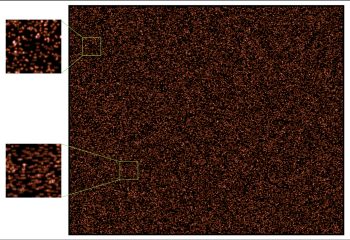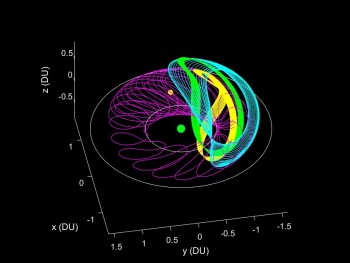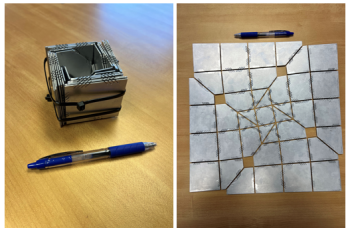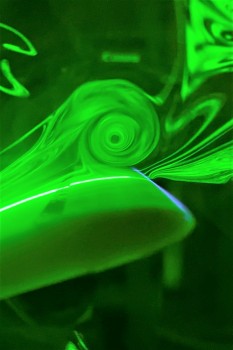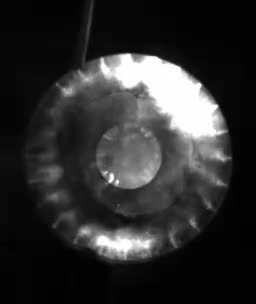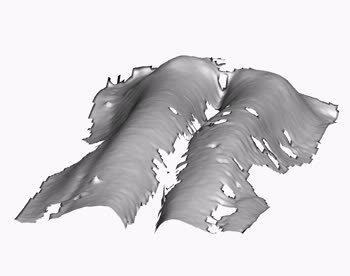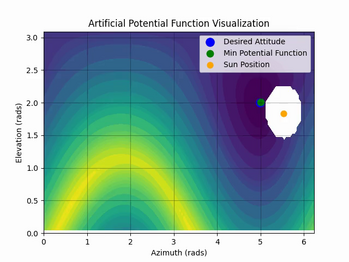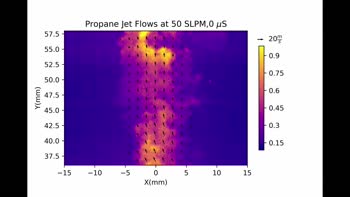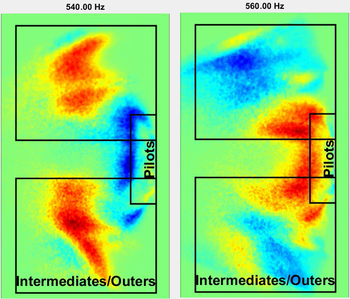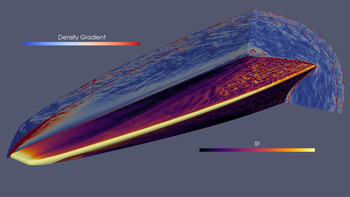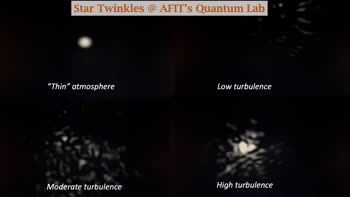List of Submitted Art-in-science Entries
Art in science entries will be listed here after approval by
the art in science chairs.
Image Entries:
Entry ID: 49DCASS-022
Preliminary Understanding of Particle Dynamics History in PIV data
Dilip Kalagotla
University of Cincinnati
Paul Orkwis
University of Cincinnati
Uncertainty due to particle lag has been well understood in PIV. However, the uncertainty related to the particle that passes through a complex flow field without relaxing with the local fluid velocity has never been explored. This image depicts the first attempt to capture this "particle dynamics history (PDH)". It gets us one step closer to quantifying the uncertainty related to PDH and helps enhance the PIV results. The transparency of two pictures was altered to create an overlapping effect in this image. One is a synthetic image generated by spawning particles in a CFD data. This was the traditional way of quantifying the particle response. The second is a synthetic image generated by spawning particles in a PDH-informed flow. The top zoom depicts the increase in intensity of particle overlap because of the particle location. The bottom zoom highlights the particle lag caused due to the particles shooting across the shock.
Entry ID: 49DCASS-064
L5 Axial Orbit Family in Jupiter-Europa-Io-Ganymede Circular Restricted N-Body Problem (CRNBP)
Annika Gilliam
Air Force Institute of Technology
Robert Bettinger
Air Force Institute of Technology
This plot displays four selected trajectories given by initial conditions in the L5 Axial orbit family of the Jupiter-Europa Circular Restricted 3-Body Problem (CR3BP) propagated instead by utilizing the CRNBP. The additional gravitational perturbations due to the influence of Io and Ganymede on the satellite's trajectory yield interesting patterns when propagated for 200 TU. The two rings demonstrate the approximate locations of Io and Ganymede. Orbits that spend more time in the x-y plane demonstrate significantly more perturbation.
Entry ID: 49DCASS-092
Origami Metal Mirror
David Garcia
Air Force Institute of Technology
Robert A. Bettinger
Air Force Institute of Technology
The origami metal flasher is intricately designed for space operations, showcasing its capability to seamlessly transition from a folded cube state to an unfolded configuration passively, achieving an impressive 86% unfolding capability.
Entry ID: 49DCASS-115
Plasma Portal
Sidaard Gunasekaran
University of Dayton
Michael Mongin
Air Force Research Laboratory
An ethereal spiral that forms during plasma jet actuation on top of a wing. A portal that is omnipresent which influences our daily lives, the airplanes we fly to the oceans we sail, distant planets, galaxies, and beyond.
Video Entries:
Entry ID: 49DCASS-060
Initiation of a Rotating Detonation Engine with an acoustic liner
Tyler Pritschau
University of Cincinnati
Jorge Betancourt
University of Cincinnati
Rachel Wiggins
University of Cincinnati
Peter Glaubitz
University of Cincinnati
Dr. Ephraim Gutmark
University of Cincinnati
This video shows the detonation-tube driven initiation of our rotating detonation engine looking in from the back. The video is captured at 100,000 frames/second and slowed down to ~1/6000th speed here. In this particular case a perforated acoustic liner was installed in the outer wall which lead to some interesting unintended interactions during the initiation process.
Entry ID: 49DCASS-069
Fluid-Structure Interaction in a Vibrating Nozzle Element
Jacob Michaud-dorko
University of Cincinnati
Charles Farbos de Luzan
University of Cincinnati
Ephraim Gutmark
University of Cincinnati
Liran Oren
University of Cincinnati
Unraveling the dynamics of wall geometry and the corresponding two-dimensional flow field using digital image correlation and particle image velocity measurements.
Entry ID: 49DCASS-132
Artificial Potential Function of Constrained Attitude Controller for In-Space, Multi-Agent Inspection
Mark Mercier
Air Force Institute of Technology
David Curtis
Air Force Institute of Technology
Multi-agent inspection missions are a key enabler for recent advances in on-orbit operations such as servicing, manufacturing, and debris removal. The ability to leverage distributed assets to collaboratively inspect a single target increases the applicability of an inspection to targets that may be in an uncontrolled rotation or have a strict time window in which inspection must take place. Often optimal trajectory design for complex scenarios, such as a multi-agent inspection, is prohibitively computationally expensive to take place on orbit and must be done offline. The attitude requirements of a multi-agent inspection mission may necessitate an attitude controller capable of enforcing a desired attitude while avoiding certain constraint zones. An Artificial Potential Function (APF)-based attitude controller enables each inspector to point towards the desired target while avoiding a sun exclusion zone. The visualization all takes place in the relative, local-vertical, local-horizontal (LVLH) frame that is centered on the inspection target.
The emergent, time-variant behavior of the APF is based on two factors. First, the sun exclusion zone moves in the relative frame as the earth moves in relation to the sun---an annual oscillating effect---and the spacecraft moves around the earth, rotating the LVLH frame---a daily oscillating effect. Second, the desired attitude for the controller is dictated based on the position of the inspector relative to the target. For an inspection, constant target pointing is typically desired and the translational movement of the inspector relative to the target dictates a constantly changing desired attitude. For this example, the inspector is placed in a natural motion circumnavigation (NMC) trajectory around the target. An important property of an NMC can be observed in the piece as any NMC around a reference orbit will have the same period as that reference orbit's inertial period. In this case, as the inertial period of the reference orbit determines both the inspector's NMC period and the rate of rotation of the LVLH frame, both time varying components move at roughly the same rate. The elevation change throughout the inspection is due to the relative inclination of the inspector's NMC.
Entry ID: 49DCASS-133
Deep Learning based Optical Flow Analysis of High-speed Jet Flows
Daniel Zhang
Farragut High School
Zifeng Yang
Wright State University
The video shows the instantaneous high-speed flow velocity and mixture image of the free propane jet with a flow rate of 50 standard liter per minute (slpm) into ambient air. Velocity vectors estimated using deep-learning based optical flow analysis, CRoss-Attentional Flow Transformer (CRAFT) are superimposed on the image. 100 consecutive image pairs within each burst were obtained with a frame rate of 100 kHz. The mixture fraction is illustrated by the colorbar on the right. The velocity magnitude is shown as an arrow above the colorbar.
Entry ID: 49DCASS-134
Propagation of Thermoacoustic Instability for Type-II Intermittent states observed at 540 Hz and 560 Hz in a MLDI Combustor
Yuvi Nanda
University of Cincinnati
Ephraim Gutmark
University of Cincinnati
Intermittent combustion oscillations are observed in a fuel staged Multi Nozzle Lean Direct Injection combustor. The combustor array is categorized into three independent fuel stages, consisting of thirteen nozzles, namely, the pilot, the intermediate, and the outer. The flame reaction zones corresponding to these nozzles have been highlighted. During these intermittent oscillations the combustor was operated at an equivalence ratio of 0.6, fuel split to the pilot nozzles was 45%, intermediate had 30% and outer had 20% of the total fuel. The unstable periodic and aperiodic thermoacoustic oscillations formed two type-II intermittency states which depicted kite-like patterns, identified through nonlinear time series analysis. Spectral Proper Orthogonal Decomposition performed on the time resolved OH* Chemiluminescence images corresponding to these intermittent states are shown here demonstrating the propagation of the instability. The first type-II intermittent state is oscillating at 540 Hz and the second is oscillating at 560 Hz.
Entry ID: 49DCASS-135
Noisy Transition
Tim Leger
Ohio Aerospace Institute
Matthew Tufts
Air Force Research Laboratory
Nicholas Bisek
Air Force Research Laboratory
CFD simulation showing the complex boundary layer transition of f-BoLT 35. Disturbances, in the form of broadband noise, are introduced to a base flow field solution outside the and along the bow shock. Flow field slices along the the symmetry and outflow planes show density gradients, while the surface is contours of Stanton number. The nose curvature of f-BoLT creates a stream-wise vortex which sweeps toward the symmetry plane, resulting in two distinct boundary layer regions. As the disturbances reach these boundary layer regions, they stimulate transition to occur in a distinct and visually pleasing pattern. Distribution Statement A: Approved for Public Release; Distribution is Unlimited. PA# AFRL-2024-0796
Entry ID: 49DCASS-136
Star Twinkles at AFIT’s Quantum Lab
Anil Patnaik
Air Force Institute of Technology
Keith Wyman, Noah Everett, Viswa Ramesh, Robert von Holle, Bille DeLuc
Air Force Institute of Technology
A laser beam with typical Gaussian beam of when passes through random change in refractive index (RI) creates speckles at image plane. Stars in the night sky twinkle because of the random change in RI caused by atmospheric turbulence. This video shows the “twinkling” caused by an emulated atmospheric turbulence using phase plates at AFIT’s Quantum Optics Lab.

